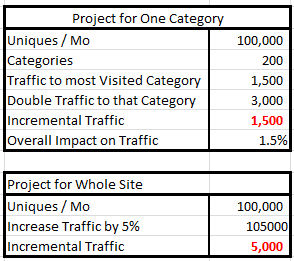Making The Case For Adding Deep Content To Large E-Commerce Sites
Large e-commerce sites present some interesting challenges, and finding ways to build up unique content on the site is one of the toughest. I recently was able to witness a case study situation, and will today share the findings from that. Like any other company, the management team in a large enterprise prefers that everyone […]
Large e-commerce sites present some interesting challenges, and finding ways to build up unique content on the site is one of the toughest. I recently was able to witness a case study situation, and will today share the findings from that.
Like any other company, the management team in a large enterprise prefers that everyone work on projects that potentially offer a large scale impact. This can be very challenging on e-commerce sites that cover dozens, or even hundreds, of categories of products.
Here are two typical business case scenarios for a given e-commerce site:
In this example, I have compared a very aggressive plan of doubling the traffic to one category with the much more modest goal of a 5% traffic gain from a horizontally focused project applied to the site as a whole. You can see why the management team is going to want to focus on site-wide projects — the potential impact is nearly always greater.
A common scalable design approach for large scale e-commerce sites is to roll up the most popular products and show those on the main page of the category. However, this does not lend itself to either SEO or landing-page optimization of the experience. Note that if you believe that landing-page optimization is an SEO factor, as I do, then that is also SEO at work.
The challenge, in a nutshell, is to sell management that approving a project to redesigning individual category pages is a worthwhile effort. There is a lot of custom work involved for each category so you can’t do them all at once, and each individual project is not going to move the overall traffic needle by a large percentage.
To succeed, you have to sell the concept of going through the major sections of the site one at a time.
Demonstrate With An Example
As is so often the case in enterprise organizations, there is great power in selling a test project to prove a concept. Management teams respond well to real test data. If you can sell one test project to show that you can impact the traffic for a single category in a significant way then you can prove that the design concept works.
That leaves you with the follow on challenge of selling more projects over time, but because you have shown with a test case that the redesign does work for an individual category, at least one potential source of risk will be off the table — that being that management will question whether the redesign concept even works.
Of course, there is a process to selling the initial project. Here are some key aspects of how you do that:
- Manage Expectations: the goal is to show a concept of what can be done over time with a series of projects. Strong category experiences can create substantial leverage for those horizontal projects.
- User Experience: testing and surveying our users can help build the argument for creating a better browse path and discoverability for customers.
- Brand Value: better user experiences on key landing pages for the site can create a different perception of the quality of the site.
- Search Engine Value: search engines try to reward sites with better user experiences.
- Horizontal Projects are Finite: there are only so many of those you can do before you start getting more marginal returns.
I had the opportunity to discuss this with one large e-tailer recently. Unfortunately, I can’t disclose who that is, but the data below is real:
- Category Re-Launch June 2012
- Doubled traffic to the category within 2 weeks and doubled again within 1 month
- Increased rankings for head terms within 1 month:
- Top Head Term: moved from #22 to #8
- Key Secondary Term: moved from unranked to #2
- Another Head Term: moved from #26 to #8
Summary
With results like these, you now have proof that the changes can help at the category level. The results from this example were spectacular (4x traffic growth to the category), and you probably should not expect that to be the norm.
By itself, the the total incremental traffic for one category may not move the overall needle at a corporate level; but, now it becomes a lot easier to sell the concept of repeating the project.
Imagine if over a 2 year period you updated all of your top categories? Strong traffic growth at that point will move the needle in a big way at that point. In addition, you will have impacted the perception of your brand in the process.
Opinions expressed in this article are those of the guest author and not necessarily Search Engine Land. Staff authors are listed here.
Related stories

